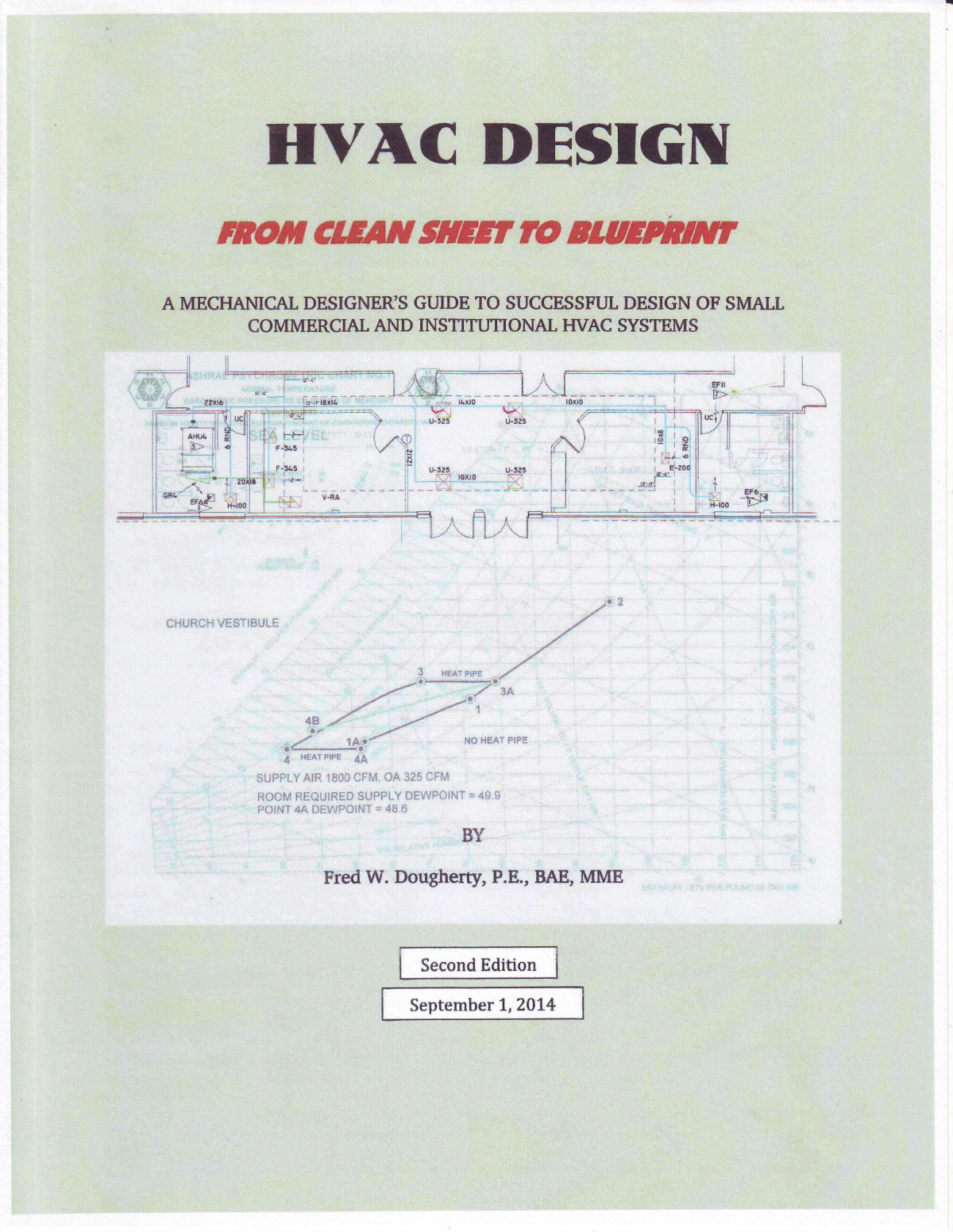
WELCOME
TO FRED DOUGHERTY’S HVAC DESIGN SITE
contact me at doughert@nettally.com

The original purpose of this site was to introduce and describe my book “HVAC Design From Clean Sheet to Blueprint”. A picture of the cover is above. The second edition of the book is now available for free download (see below). Also, the site includes free download of an excel spread sheet to compute duct sizes, and to link to on-line continuing education courses I have authored. Those courses are also available for free download, but to obtain continuing education credit, the student must enroll in pdhonline.org. But who is Fred Dougherty? I am a mechanical engineer with more than 50 year’s experience, including 30 years as an engineer of building mechanical systems. Please review my resume.
HVAC Design From Clean Sheet to Blueprint
A Mechanical Designer's Guide to Successful Design of Small Commercial and Institutional HVAC Systems
HVAC Design from Clean Sheet to Blueprint is a comprehensive design manual with a step-by-step methodology for successful desi gn of small commercial/institutional HVAC projects – defined as building modules under 25,000 sf and with DX unitary equipment air conditioners up to 30 tons.
The procedures and principles described will be of value to technicians and graduate engineers with a firm background in thermodynamics and fluid flow – the bedrock fundamentals of HVAC processes. It is for engineers and technicians who are just entering the HVAC design field as members of a consulting engineering firm, or who wish to work independently designing HVAC systems for small offices, mercantile establishments, churches, and restaurants for local architects and owners. Also interested will be knowledgeable HVAC contractors who wish to do small project design where permitted by local codes, such as Florida's "threashold building" exemption. To see what the book is about,download the Table of Contents. A descriptive note is added under each chapter heading.
Please note that examples and calculations in the book are in IP units. This should not inhibit SI users because the methodology is easily understood qualitatively. An SI version will soon be available. If you would be interested in the SI version, please send me an e-mail to let me know.
This book may be downloaded for free. For more about the book, and to download, click here. Reproduction is permitted. If parts of the book are printed, please acknowledge authorship. The book is offered with no warranty, and the author is not responsible for any outcomes resulting from its use, reproduction, or distribution.DUCT SIZE WITH EQUAL FRICTION USING EXCEL SPREAD SHEET
As part of my long practice as an HVAC consultant, I developed a spread sheet that sizes ductwork and presents results directly useful in design. The spreadsheet was featured by ASHRAE in an article in May 2009. In January 2011, I upgraded my duct size spreadsheet to make it easier to use and understand.
The user can define a duct system by supply and return segments and can input air flow and desired duct height for each segment. The program will return hydraulic duct diameter and duct width. If duct height is input as zero, then the program will return duct diameter to the nearest integer inch if smaller than 10”, and to the nearest even inch if greater. Likewise, duct width is returned to the nearest integer inch. The program also returns friction loss, dynamic fitting loss, and external static pressure for fan selection.
To review and use my spreadsheet for sizing HVAC ductwork, click here. For information about the continuing education courses I have authored, continue.
CONTINUING EDUCATION COURSES FOR ENGINEERS
HVAC Ventilation for Indoor Air Quality - Before final heating and cooling loads can be calculated for a building, the required minimum amount of outdoor air for ventilation must be determined. This 2 hour course explains the principles of non-residential HVAC ventilation and why inducing outdoor air into a conditioned space is essential. This course will enable the designer to determine the minimum level of ventilation air for a project that will control indoor air quality and meet required standards and codes while using the least possible amount of energy. Methods of introducing ventilation air are discussed in detail.
HVAC Psychrometric Analysis to Avoid Moisture Problems - Psychrometric analysis is required to ensure that a selected air conditioning system can deliver design room temperature and relative humidity. This course explains how to set up psychrometric analysis and plot state points and process lines for room loads and cooling coil capacity on a psychrometric chart. Examples of systems with varying occupancy and outdoor air are presented using actual HVAC projects. These examples show how psychrometric analysis can spot potential moisture problems and lead to solutions. Three hours of continuing education credits.
Air Side Economizer Design Using Psychrometric Analysis - Since the economizer mandate first appeared in ASHRAE Standard 90.1 in 2004, there has been very little guidance for designers in the professional literature. In particular, there is virtually no guidance on selecting the economizer cutoff high limits, other than a few articles in professional and commercial journals that emphasize energy saving and dismiss occupant comfort considerations. This course provides the first comprehensive design recommendations that cover damper quality control as well as methods to set high limits for energy saving without compromising occupant comfort. Three hours of continuing education credits.
These courses, plus many others by other authors, are available at PDH Online to fulfill continuing education requirements for engineers in most of the United States. Register and go to “HVAC, Plumbing, and Fire Protection” under the PDH Online Course Library. The course numbers are M384, M409, and M410, respectively. They may be viewed and studied without paying a fee. A fee is required only to take the quiz and receive credit.
To contact me, e-mail doughert@nettally.com